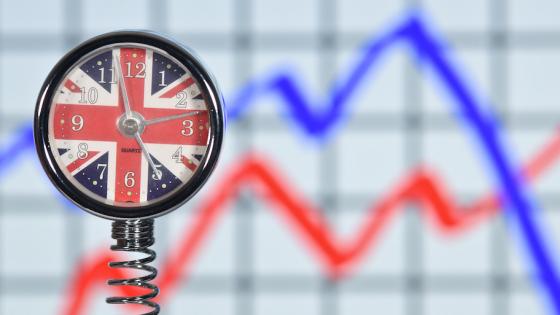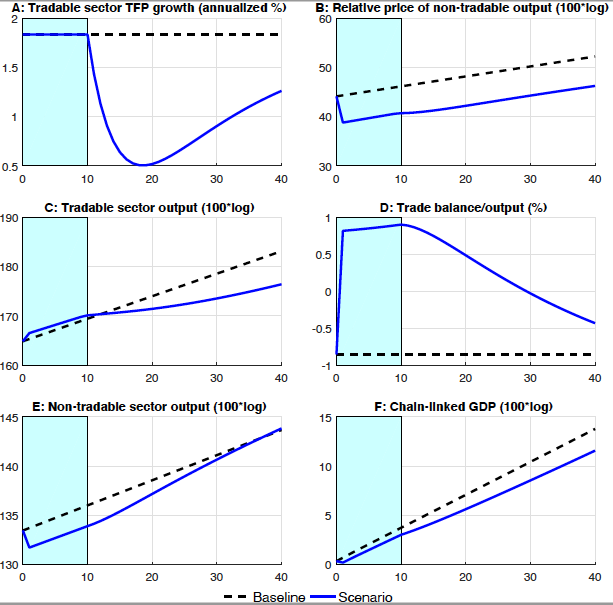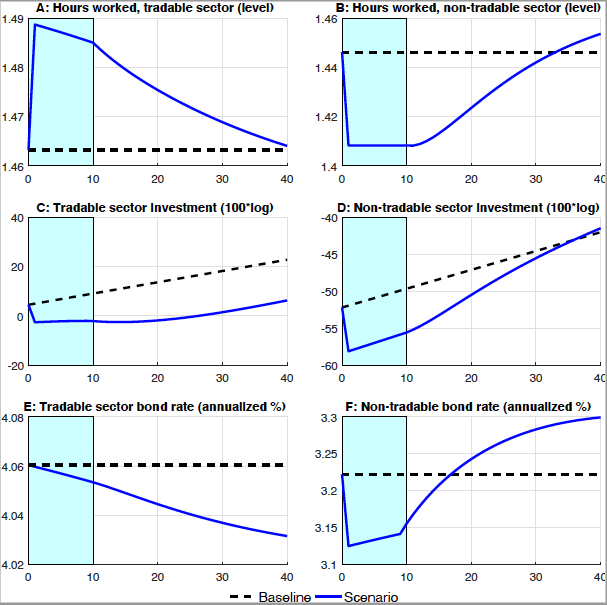In the momentous referendum on 23 June 2016, voters decided that the UK should leave the EU. While many of the details regarding the UK’s ultimate withdrawal still need to be determined, economic research has shed light on a number of aspects of the referendum and its consequences. Relevant research has highlighted long-run trade effects (Dhingra et al. 2017, Sampson 2017), foreign direct investment (McGrattan and Waddle 2018) and financial market volatility and stock returns (Davies and Studnicka 2018). Existing papers have also focused on uncertainty about the final UK-EU trade arrangement in a general equilibrium setting (Steinberg 2017), the role of uncertainty shocks using the Decision Maker Panel (Bloom et al. 2018, Faccini and Palombo 2019) and the extent of exchange rate pass-through following the referendum (Forbes et al. 2018). Born et al. (2018) apply a synthetic control method to study the effects of Brexit on UK growth.
The macroeconomic adjustments to the Brexit vote
In a recent paper (Broadbent et al. 2019), we document how the aftermath of the referendum has been characterised by significant macroeconomic adjustments in the UK economy. In doing so, we make use of novel UK quarterly macroeconomic data for tradable and non-tradable labour productivities and the relative price of sectoral outputs.
Figure 1 presents the key facts. Panels A and B are intended to show the change in aggregate UK growth relative to pre-referendum trends and expectations. Panel A is from Vlieghe (2019) and plots the deviation of UK GDP from a ‘no Brexit’ counterfactual constructed using a synthetic control based on a pool of other countries’ GDP. A marked decline is visible, indicating that growth slowed after the referendum relative to what might have been expected in the absence of Brexit. Panel B provides an alternative view of this effect and shows that the IMF revised down the outlook for GDP growth after referendum.
Panel C decomposes the weakening of aggregate output into tradable and non-tradable gross value added. While the two sectors show a parallel trend prior to the referendum, there is a sharp break in the growth rate of the non-tradable sector after the referendum. Panel D presents the relative price of non-tradable to tradable output together with the real effective exchange rate (REER). As shown in the exposition of our two-sector business cycle model, these concepts are closely related. It is evident that the UK real exchange rate depreciates sharply after the referendum. Panel E plots exports and the trade balance, both measured as a percentage of GDP. While the patterns in this panel are less stark, they suggest that UK trade improved robustly following the Brexit vote. Panels F and G show the evolution of aggregate factors of production. While total investment weakened following the referendum, the labour market has remained resilient.
Panel H shows ten-year zero coupon yields for the UK and the US. These yields closely track each other prior to the Brexit vote but a spread opens up thereafter. UK yields have remained persistently below their US counterpart in the aftermath of the referendum. Omitting inflation risk and term premia considerations, this pattern is already indicative of a mechanism by which market participants may have perceived a reduction in UK productivity growth relative to the US.
Figure 1 Adjustments of the UK economy following the Brexit vote
A simple economic interpretation of the adjustments: Negative news about productivity in the tradable sector
In Broadbent et al. (2019) we argue that the facts presented in Figure 1 are consistent with what economic theory predicts for the effects of an anticipated productivity growth slowdown in the UK tradable sector. This basic idea is motivated by the remarks of Broadbent (2017), who conjectured that market participants may have interpreted the consequences of the Brexit vote as a future slowdown in the tradable sector, prompting the depreciation of sterling following the referendum. We formalise and assess this idea through the lens of a quantitative small open economy model with tradable and non-tradable sectors estimated using UK macroeconomic data. Our two-sector model allows us to characterise how firms and households respond to news about future productivity in the tradable sector by shifting resources across expenditure components, sectors and time. We demonstrate that the macroeconomic dynamics triggered by news about a disruption in the tradable sector are consistent with the broad patterns in the data following the referendum. While the effects of the referendum encompass a variety of economic channels, our analysis provides an explicit formal framework to interpret some of the macroeconomic responses to the Brexit vote.
Figures 2 and 3 show the responses of key macroeconomic variable in our model (which is estimated using our novel macroeconomic data set up to June 2016). The responses are the responses to a news shock about lower productivity growth in the tradeable sector 11 quarters in the future. This timing is motivated by the fact that Article 50 was triggered several months after the referendum result.
Figure 2 Model responses to news about lower productivity growth in the tradable sector
Figure 2 reveals that the permanent drop in tradable sector productivity (depicted in Panel A) leads to a permanent fall in the relative price of non-tradable output, since it will become relatively more efficient to produce. Panel B shows that the price of non-tradable output falls immediately, even before the reduction in productivity growth has materialised. During the anticipation phase, tradable goods are relatively profitable to produce because the reduction in productivity growth has not yet materialised. As shown in panels C and D, this effect encourages production of tradable goods and exports in the near term. Once productivity slows down, however, tradeable output declines and the trade balance deteriorates in the longer term. Unsurprisingly, the profile of non-tradable moves in the opposite direction to tradable output, as shown in panel E. During the anticipation phase, non-tradable output is relatively unprofitable and output declines. As the drop in productivity materialises, non-tradable output becomes relatively profitable, which generates a long-term sectoral recovery. Eventually non-tradable output converges back to its pre-shock trajectory given that the balanced growth path for the non-tradable sector is unaffected.
The net effect of the opposing forces on the tradable and non-tradable sectors gives rise to a muted response of GDP (panel F). The initial response of GDP is small, but the effect builds over time. We calibrate the size of the initial shock so that GDP is around 3% lower in the long run.
Figure 3 Model responses across sectors
Figure 3 shows the responses of the factors of production and rates of return. The inter-sectoral reallocation is consistent with the main mechanism underpinning our results: the tradable sector is relatively more profitable during the anticipation phase and less profitable once news materialise. Panels A and B show that labour shifts from the non-tradable sector to the tradable sector during the anticipation period, to support the production of tradable goods. Overall, total employment rises during the anticipation phase. This pattern reverses once productivity growth in the tradable sector actually starts to fall. Panel C shows that investment in the tradable sector falls sharply before slowly converging to a new, lower level. Investment prospects in the tradable sector are dominated by the expected longer-term decline in productivity. In contrast, panel D shows that, while non-tradable investment initially shows a marked slowdown, it subsequently rises above the baseline path.
On aggregate, there is a significant near-term fall in investment and the labour market remains robust. Taken together, the responses can be seen as an economy-wide shift from capital towards labour, a feature of recent UK data that has been highlighted by some commentators. Panels E and F show the real bond returns in both sectors. The small decline in the bond rate denominated in tradable goods is driven entirely by the debt elastic premium in our model. The return on bonds denominated in non-tradable output falls during the anticipation phase, before rising above the steady-state level.
The model simulations, which capture the basic notion about news in productivity in the tradable sector, perform very well in matching the broad contours of UK macroeconomic performance since the referendum. While Brexit encompasses a variety of economic mechanisms, our work in Broadbent et al. (2019) aims to provide a simple and concise framework in which macroeconomic adjustments to this momentous historical event can be interpreted.
References
Bloom, N, P Bunn, S Chen, P Mizen, P Smietanka, G Thwaites and G Young (2018), “Brexit and uncertainty: Insights from the decision maker panel”, Fiscal Studies 39(4): 555–580
Born, B, G Muller, M Schularick and P Sedlacek (2018), “The Costs of Economic Nationalism: Evidence from the Brexit Experiment”, CEPR Discussion Paper 12454.
Broadbent, B (2017a), “Brexit and interest rates”, speech given at the London School of Economics, Bank of England.
Broadbent, B, F Di Pace, T Drechsel, R Harrison and S Tenreyro (2019), “The Brexit vote, productivity growth and macroeconomic adjustments in the United Kingdom”, CEPR Discussion Paper 13993
Davies, R B and Z Studnicka (2018), “The heterogeneous impact of Brexit: Early indications from the FTSE”, European Economic Review 110: 1–17.
Dhingra, S, H Huang, G Ottaviano, J Paulo Pessoa, T Sampson and J Van Reenen (2017), “The costs and benefits of leaving the EU: trade effects”, Economic Policy 32(92): 651–705.
Faccini, R and E Palombo (2019), “Policy uncertainty in Brexit U.K.”, Technical report, Queen Mary (mimeo).
Forbes, K, I Hjortsoe and T Nenova (2018), “The shocks matter: Improving our estimates of exchange rate pass-through”, Journal of International Economics 114(C): 255–275
McGrattan, E R and A L Waddle (2018), “The Impact of Brexit on Foreign Investment and Production”, American Economic Journal: Macroeconomics, forthcoming.
Sampson, T (2017), “Brexit: the economics of international disintegration”, Journal of Economic Perspectives 31(4): 163–84.
Steinberg, J (2017), “Brexit and the Macroeconomic Impact of Trade Policy Uncertainty”, 2017 Meeting Papers 216, Society for Economic Dynamics.
Vlieghe, G (2019), “The economic outlook: fading global tailwinds, intensifying Brexit headwinds”, Speech given at Resolution Foundation, London.











